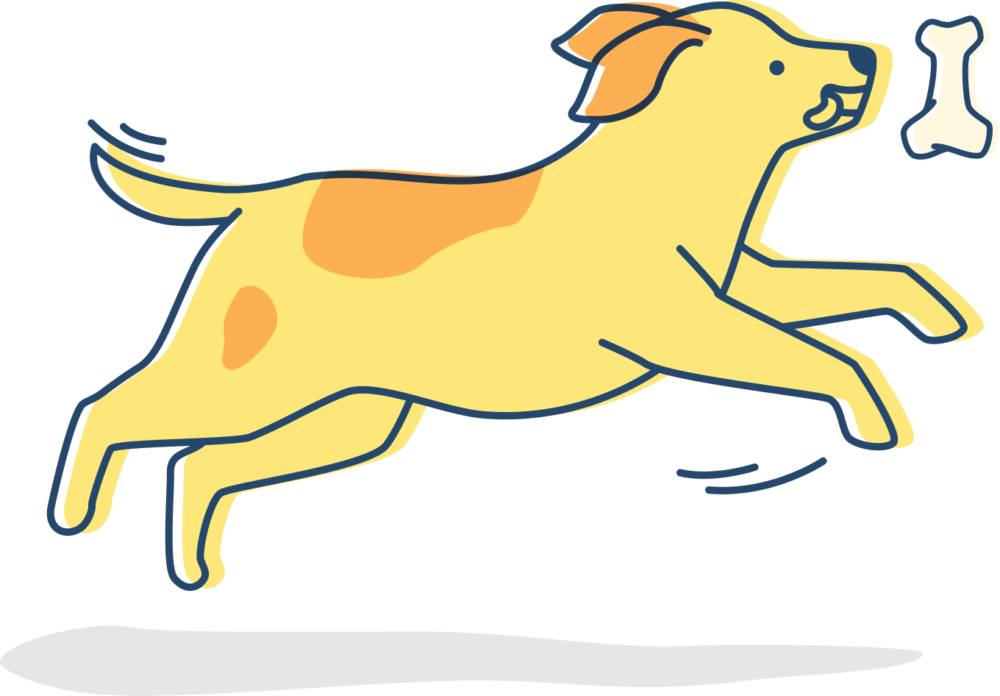The German shepherd pug mix is a hybrid dog breed that crosses the German shepherd and the pug. This designer dog breed was created to combine the best of both breeds into one package. They are also known as Shug dogs. The German shepherd pug mix is a loyal, loving, and affectionate dog that makes a great companion for families with children.
The affectionately named “Shug” is the perfect size for any elderly family member looking for a companion, or indeed any family pet. This curious mix of two medium-sized dogs produces an adorable companion pet. Let’s take a closer a look at where the German Shepherd Pug mix comes from by looking at its parent breeds, what you can expect from your Shug and where you can find yourself a German Shepherd Pug mix for your family or elderly family member.
Insights
They are also known to be good guard dogs, as they are very protective of their family and home. German shepherd pug mixes are intelligent dogs that are easy to train and make great obedience or agility partners. They are also known for being good watchdogs, as they bark at strangers or anything that seems out of place.
| Height: | 9–16 inches |
| Lifespan: | 10 –15 years |
| Weight: | 15–50 pounds |
| Coat colours: | Black, brown, tan, cream. |
| Temperament: | Intelligent, healthy, playful, sociable. |
| Suitable for: | First-time dog owners, Families with kids, The elderly, less-active family units, and single individuals. |
What Does a German Shepherd Pug mix Look Like?
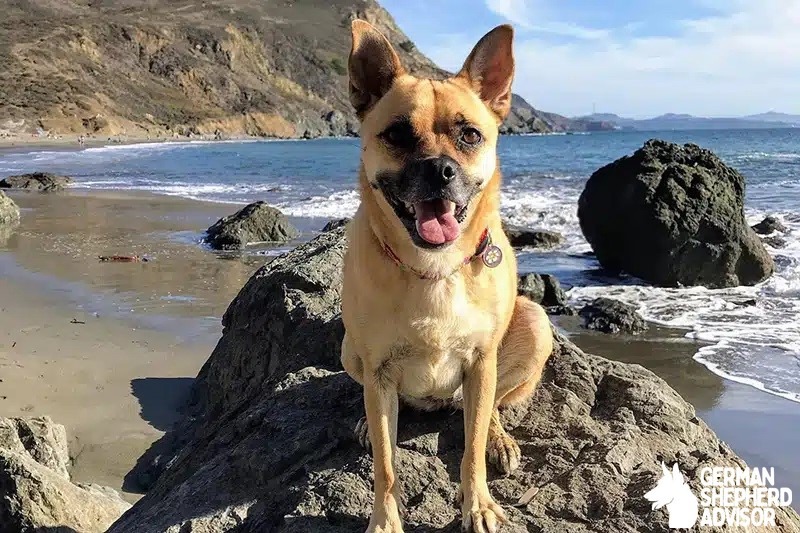
The German Shepherd Pug mix will borrow a decent amount of its looks from both of its parent breeds, usually maintaining (roughly) the size of the Pug and the short, curly tail, as well as the short, bristly fur of the Pug. It will likely have the nose, mouth and head shape of the German Shepherd, with the ears of the Shepherd.
The History of the German Shepherd Pug Mix
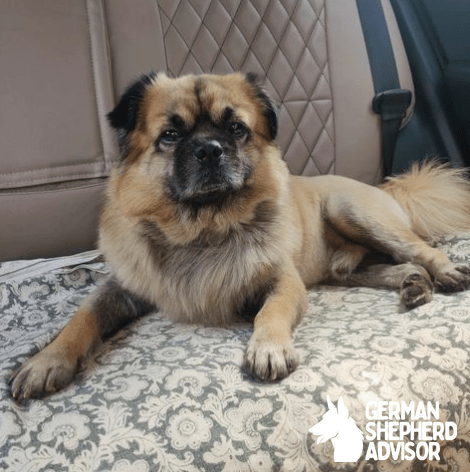
As the German Shepherd Pug mix is a relatively new mixed breed of dog, little is known about it’s history. Though it’s believed that the Shug was crossbred as recently as the 1990s or 2000s, when crossbreeding of dogs became popular.
Photo credit: spiketheshug
To help us understand more about the crossbreeding of the German Shepherd and Pug, it’s best to take a look at their parent breeds.
Physical Attributes
German shepherd pug mixes typically weigh between 15 and 50 pounds and stand between 10 and 16 inches tall at the shoulder. They have a short, dense coat that is usually black and tan, although some may have a more pug-like appearance with a fawn or apricot coat. German shepherd pug mixes are generally healthy dogs, but like all hybrid breeds, they can inherit health conditions from either parent breed. Some common health problems affecting German shepherd pug mixes include hip dysplasia, elbow dysplasia, von Willebrand’s disease, and patellar luxation.
German shepherd pug mixes typically live between 12 and 15 years. If you are thinking about adopting a German shepherd pug mix, be sure to do your research on both parent breeds to see if this hybrid is the right fit for you and your family. German shepherd pug mixes make great companion dogs and are known for their loyalty, loving nature, and affectionate personality. They are also relatively easy to train and make great obedience or agility partners. German shepherd pug mixes are popular among dog lovers for their unique appearance and personality. But before you bring one home, it’s important to research to ensure this breed is right for you and your lifestyle.
Here are a few things to consider before getting a German shepherd pug mix:
Energy levels:
German shepherds are high-energy dogs, while pugs are relatively low-energy. This means that a German shepherd pug mix can have varying energy levels. This differs from your breed if you’re looking for a couch potato dog.
Exercise needs:
German shepherds and pugs need daily exercise, but the amount and intensity will vary depending on which parent breed your dog takes after more. German shepherds need much more vigorous exercise than pugs, so if you’re not prepared to walk or run with your dog for at least an hour a day, there are better breeds for you.
Grooming needs:
German shepherds are heavy shedders, while pugs don’t shed very much. This means that a German shepherd pug mix can have varying grooming needs depending on which parent breed they take after more. If you’re prepared to deal with daily shedding, this is only the right breed for you.
Training needs:
German shepherds and pugs can be stubborn, but they are both highly intelligent breeds. This means a German shepherd pug mix can be difficult to train if they take after its German shepherd parent more. If you need to prepare to put in the time and effort to train your dog, this isn’t the right breed for you.
Size:
German shepherds are large dogs in comparison to pugs. Pugs are small dog breed. This means that a German shepherd pug mix can vary greatly in size depending on which parent breed they take after more. If you’re prepared to have a large dog, this is only the right breed.
Life expectancy:
German shepherds have an average life expectancy of 9-13 years, while pugs have an average life expectancy of 12-15 years. This means that a German shepherd pug mix can have a shorter or longer lifespan depending on which parent breed they take after more.
Health concerns:
Both German shepherds and pugs are prone to certain health problems. A German shepherd pug mix can inherit some of these health problems. Some common health concerns for this breed include hip dysplasia, elbow dysplasia, von Willebrand’s disease, and Pug Dog Encephalitis (PDE).
Cost:
German shepherds and pugs can both be expensive breeds to purchase and maintain. This means that a German shepherd pug mix can also be an expensive dog to own. Be prepared to budget for food, vet bills, grooming, and more.
Owning a German shepherd pug mix
If you’re prepared to handle the challenges of owning a GSd pug mix, this breed may be right for you. They are unique dogs with their distinct personalities. But before you bring one home, research to ensure this breed is a good fit for your lifestyle. If you’re considering a German shepherd pug mix, you should know a few things. First, they are an active breed and need plenty of exercise. They also require regular grooming, including brushing and ear cleaning. And lastly, they can be stubborn, so that training may take some patience. But if you’re up for the challenge and have the time and energy to invest, a German shepherd pug mix can make a loyal and loving companion.
Regarding feeding, German shepherd pug mixes are not overly demanding. They do best on high-quality dry food supplemented with fresh fruits and vegetables. Remember that these dogs can be stubborn for training, so patience is key. Work your way up from starting with basic obedience commands. As for grooming, regular brushing and ear cleaning are required to keep your German shepherd pug mix-looking and feeling his best.
The German shepherd pug mix is a cross between the German shepherd and the pug. This hybrid dog has the best of both worlds, being intelligent and protective like the German shepherd and playful and affectionate like the pug. This mix is an ideal pet for families with children, as they are gentle and good-natured. They require some exercise, so a daily walk or playtime in the garden is essential.
Feeding ratio
When it comes to feeding your German shepherd pug mix, there are a few things you need to bear in mind. Firstly, this breed is prone to obesity, so it’s important to choose a high-quality food that is low in fat and calories. You should also avoid foods high in sugar or artificial additives, which can cause health problems.
Feeding your German shepherd pug mix twice a day rather than just once is also a good idea. This will help prevent overeating and allow them to digest their food more effectively. If you need to figure out what food to give your German shepherd pug mix, you should talk to your vet for advice.
They will be able to recommend a suitable diet based on your dog’s individual needs. The German shepherd pug mix is a great pet for families with children. They are affectionate and gentle but also need some exercise to stay healthy.
Training
One of the great things about owning a German shepherd pug mix is that they are relatively easy to train. This is due to their intelligence and eagerness to please their owners. However, like all dogs, they will need some patience and consistency regarding training.
Here are a few tips to get you started:
- Start with basic obedience commands such as sit, stay, come, and down. Use positive reinforcement, such as treats or praise, when your dog responds correctly.
- If you plan on taking your German shepherd pug mix on walks or hikes, train them early on how to walk politely on a leash. This will prevent them from pulling or tugging while you are out.
- German shepherd pug mixes are known for protecting their family and home. While this can be a good trait, it is important to teach your dog when it is appropriate to bark and when it is not. This will help prevent them from becoming nuisance barkers.
- As previously mentioned, German shepherd pug mixes are very intelligent dogs. Because of this, they excel in canine sports such as agility and flyball. If you are interested in competition, consider enrolling your dog in a class or attending local trials.
- Finally, remember that every dog is different and will learn at their own pace. Be patient with your German shepherd pug mix, and don’t hesitate to ask for help from a professional trainer. With a little time and effort, you will have a well-trained dog you can be proud of.
Shedding
Consider a German Shepherd pug mix if you’re looking for a hypoallergenic dog that doesn’t shed. Also known as a Shepug, this adorable hybrid combines the best of both breeds: the German shepherd’s loyalty and protective instincts with the pug’s cuddliness and playfulness. While they don’t shed much, German shepherd pug mixes require some grooming. Their double coats can get tangled and matted, so regular brushing is necessary. But if you’re up for keeping your Shepug well-groomed, you’ll be rewarded with a loving and devoted companion.
Here are some shedding tips for German shepherd pug mixes:
- Brush your Shepug’s coat regularly. A good brushing once or twice a week will help to prevent tangles and mats.
- Use a de-shedding tool. A de-shedding tool can help to remove loose hair from your Shepug’s coat.
- bath your Shepug as needed. Bathing your Shepug once every few months will help to keep its coat clean and healthy.
- Keep your Shepug’s nails trimmed. Regularly trimming your Shepug’s nails will help to prevent them from getting too long and uncomfortable.
- Check your Shepug’s ears. German shepherd pug mixes are prone to ear infections, so check their ears regularly and clean them as needed.
By following these shedding tips, you can help to keep your German shepherd pug mix’s coat healthy and looking its best.
Lifespan
The lifespan of a German shepherd pug mix can vary depending on the health and genetics of the individual dog. However, on average, these dogs have a lifespan of 10-15 years. Some German shepherd pug mixes may live even longer with proper care and nutrition. If you are considering adding a German shepherd pug mix to your family, be prepared for a furry friend that will be a part of your life for many years to come!
Weight
The GSd pug mix is a hybrid dog breed created by mixing the German shepherd and the pug. This mixed breed inherits both parent breeds’ best physical and personality traits. The Gsd pug mix is a medium-sized dog with a muscular and athletic build. They have short, thick coats that can be black, brown, or fawn. The average weight of this hybrid dog breed is between 15 to 50 pounds.
This mixed breed is an intelligent and loyal dog that makes an excellent companion for families with children. They are also known to be good watchdogs because of their protective nature. The German shepherd pug mix is an active dog breed that needs plenty of exercises and mental stimulation to prevent them from getting bored. If you are looking for a German shepherd pug mix, you can find one at your local animal shelter or rescue organization.
Health issues in detail
The German shepherd pug mix is prone to certain health problems like any other mixed breed. Some of the most common health problems to which this mix is susceptible include hip and elbow dysplasia, patellar luxation, eye problems, and skin allergies. Hip and elbow dysplasia are two of German shepherd pugs’ most common health problems. Hip dysplasia is a condition where the ball and socket joint of the hip don’t fit together properly, leading to crippling lameness. Elbow dysplasia is an equivalent disorder that affects the elbow joint. Both of these conditions can be painful and expensive to treat.
Patellar luxation is another common health problem in German shepherd pugs. This condition occurs when the kneecap pops out of place. This could be quite painful and require surgery to fix it. Eye problems are also relatively common in German shepherd pugs. Some of the most common eye problems include cataracts, glaucoma, and cherry eye. Cataracts are a clouding of the eye’s lens, which can eventually lead to blindness. Glaucoma is increased pressure in the eye that can also lead to blindness. Cherry eye is a condition where the third eyelid prolapses and becomes visible. These conditions can be treated with surgery, but they can be expensive.
Skin allergies are also relatively common in German shepherd pugs. The most common allergens that can trigger a skin reaction include pollen, dust mites, and mold. Treatment for skin allergies typically includes antihistamines and steroids. While the GSd pug mix is prone to some health problems, they are generally healthy dogs. Your German shepherd pug mix should enjoy a long and happy life with proper care and regular vet check-ups.
The History of the German Shepherd
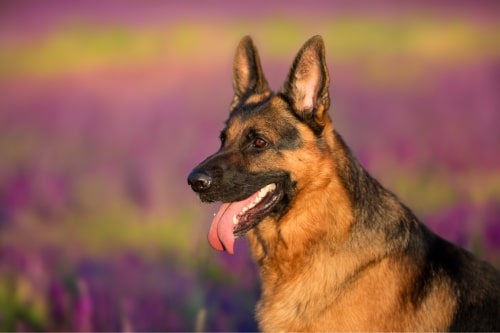
The history of the German Shepherd stretches back to (you guessed it), Germany! They were originally bred in the 19th century by Max von Stephanitz for use as a herding dog, from a variety of previous German herding dogs. Though due to their large size, intelligence and ability to follow commands, the German Shepherd has found itself taking on many different roles throughout the years, including in police and military work, and as a disability-assistance dog.
How Popular Are They?
The German Shepherd is one of the most popular dogs in the United States, likely for their multi-use capacity, obedience and generally friendly nature. They ranked 4th in the American Kennel Club’s list of most-popular dogs in 2021.
Who Are German Shepherds a Good Dog For?
Due to their size, German Shepherds aren’t suitable for the elderly, but they do make wonderful family pets and great pets for single individuals, with enough space and time to give them the exercise they desperately need to live long and healthy lives.
How Did The German Shepherd Come About?
The German Shepherd was the creation of Max von Stephanitz in the nineteenth century in Germany, it was originally created as a herding dog to help German farmers herd cattle. However, today, it occupies many different roles, including as a police military working dog, and as a disability assistance and beloved family pet.
When Did First Cross-Breed The German Shepherd?
Given the age of the German Shepherd as a breed, it’s hard to tell exactly when the dog was cross-bred, though given its age we can surmise that it has been crossbred with other breeds long before crossbreeding of dogs became popular in North America in the 1960s, and peaked in the 1990s and early 2000s.
The History of the Pug
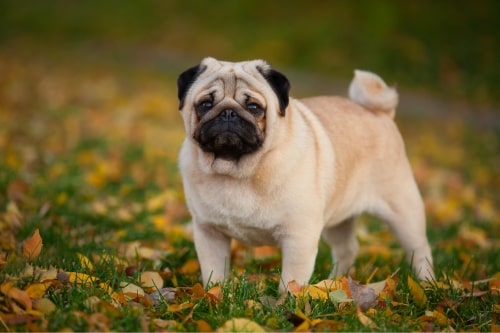
By contrast to the German Shepherd, the Pug was bred to be a lapdog and companion pet of Chinese royalty and nobility, dating back as far as 400 B.C. You may see depictions of Chinese nobility with their Pugs on their lap. The Pug began life in China but migrated to Europe in the 17th century as trade began to open up between Asia and Europe. From there, the Pug will have become a staple of American life through the migration of Europeans to the United States in the 19th century.
How Popular Are Pugs?
The Pug’s popularity in the US is almost exclusively as a companion pet. Though it is far from the most popular dog in the country, it holds a respectable level of popularity, ranking below forty routinely. Last year, the Pug was the 33rd most popular dog in America.
Who Are The Pugs a Good Dog For?
Pugs are great companion pets for just about anyone. Their laissez-faire attitude to life and low-maintenance requirements when it comes to exercise and grooming make them the perfect pet for the elderly. Though they’ll fit right in to almost any family unit.
How Did The Pug Come About?
Pugs were originally bred in China, and first appeared around 400 B.C as lapdogs and companions of Chinese royalty and nobility.
When Did First Cross-Breed The Pug?
The history of crossbreeding the Pug is largely a mystery – given their smaller size, it’s hard to imagine that much crossbreeding would have occurred during the early years of the Pug’s existence. Crossbreeding in the United States began to gain popularity in the 1960s and peaked in the 90s and 2000s, therefore we can assume that the Pug would have likely been crossbred during this time period.
How Important Is a Dog’s Temperament to Your Family?
A dog’s temperament is brought on by a multitude of factors and can change over time – from its upbringing and living environment, to its genes and activity levels – knowing what your new dog’s temperament is likely to be will only be an asset for you as you embark on the dog ownership adventure!
If you’re an active family, you’re goin to want an active pet, whereas if you’re more laid back, you’ll want to have a pet that matches that lifestyle. Failure to thoroughly research your dog’s temperamental tendencies could have disastrous, traumatic consequences for you and your new dog. Even leading to rehoming, or having to put a bunch of money into training, above and beyond that which is normally expected of a new owner.
What is the Temperament of the German Shepherd Pug Mix?
Luckily for most German Shepherd Pug owners, the Pug and German Shepherd’s temperamental tendencies blend well together, creating a relatively even-tempered dog that adopts the best of both parent breeds. Expect a highly intelligent, energetic, friendly dog with a happy disposition and lots of love to give!
Is the German Shepherd Pug Mix Friendly?
In general, German Shepherd Pugs are quite friendly animals, you can expect them to be somewhat aloof with strangers, but very friendly to those they know and love!
Is the German Shepherd Pug Mix Easy to Train?
Despite the Pug’s stubborn disposition, the German Shepherd is an incredibly attentive, intelligent and obedient dog – you can expect this to shine through in the mixed-breed, though you might have to work slightly harder to compensate for the Pug’s stubbornness.
How Much Can The German Shepherd Pug Mix Weigh?
The German Shepherd Pug mix will typically weigh between 15 and 50 pounds.
How Tall Can The German Shepherd Pug Mix Get?
You can expect the German Shepherd Pug mix to stand between 8 and 12 inches tall.
Similar Sized Breeds
Though the Shug is classified as ‘medium’ sized dog. Other similar breeds include the Nova Scotia Duck Tolling Retriever, Australian Shepherd, Beagle, Cocker Spaniel and others!
Does the German Shepherd Pug Mix Shed?
The German Shepherd Pug mix is a minimally shedding dog. This will mean you won’t have to brush them twice a week, and should only really need to brush them once every couple of weeks, or if you notice excessive shedding taking place.
How Much Exercise Does A German Shepherd Pug Mix Require?
Luckily for most owners, the Shug won’t require a huge amount of exercise – but still will require a brisk daily walk, though given the Pug’s propensity for health issues relating to its breathing, you don’t want to over-exercise your Shug! We recommend half an hour to forty-five minutes of exercise per day.
How Long Can a German Shepherd Pug Mix Lifespan?
The life expectancy of your typical German Shepherd Pug mix is between 10 and 15 years.
What Health Conditions Could the German Shepherd Pug Mix Have?
- Elbow & Hip Dysplasia
- Gastric Torsion
- Brachycephalic Obstructive Airway Syndrome (BOAS), if inherited the Pug’s short face.
- Dermatitis (skin infection).
How Can You Find a German Shepherd Pug Mix Puppy For Sale?
Initially, we recommend that you try adopting a Shug, before you search for a puppy to buy. You can begin by checking your local veterinary clinic or animal shelter. If those fail, then you can try looking online at https://www.petfinder.com/, the website where you can search for adoptees in your locality!
How Much Does a German Shepherd Pug Mix Puppy Cost?
If your attempts at adoption have failed and you’d like to try buying a German Shepherd Pug puppy instead, then we recommend that you start off by reading and following the AKC’s advice on finding a reputable breeder.
Before you start searching for a breeder for your Shug, you should know that you can expect to fork out anywhere from $500 – $2000. (Yet another reason to try your best to adopt).
Is the German Shepherd Pug Mix the Right Breed For You?
The Shug is the perfect medium-sized dog for almost any household. Their size makes them ideal for apartment owners and the elderly. So, if you’ve been looking for a companion pet who’s low maintenance, somewhat energetic, and absolutely adorable – then the Shug might just be the pet for you!
Frequently asked questions
The website 101dogbreeds claims that “the Shug dog is a medium-sized breed formed by mixing the German Shepherd and the pug.”
Because the Chug is a relatively new breed, minimal size guidelines exist. As a result of his Chihuahua and Pug parents, Chugs is expected to be on the little side. Chugs often weigh ten to twenty pounds and stand between ten and fourteen inches tall.
